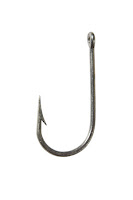Covering over 70% of our Earth, the oceans' waters hold amazing, beautiful, bountiful and just plain strange animals, and many other life forms besides!
...But what happens when the ocean begins to become... not bountiful? What happens when humans begin to realize that the fishes are getting scarce?
 |
| Without these herring, it would be very difficult for this whale and many other animals to find food! |
This goby is keeping watch for predators,
while the shrimp next to it digs a hole.
When a predator comes, the shrimp gets the
warning from the goby and both rush
into the hole!
|
Overfishing is the practice of taking too many fishes out of the ocean at once. When too many fishes are taken, not only does their overall number fall, but their ability to find appropri- ate mates in order to reproduce! This sets a chain reaction, because if one species of fish becomes endangered, then an entire line of marine animals could soon follow due to that one endangered fish not fulfilling its role in the ecosystem.
Right now, the ocean's fishes are disappearing at an alarming rate. It is estimated that the large 'factory vessels' are fishing out what could be sustainably managed on two to three Earths! These factory boats are the size of football fields, staying out at sea for up to six months, and using advanced electronic equipment to track fish schools. They store thousands of tons of fishes in colossal freezer compartments on board. Also, cruel methods are used to catch the fish that often involve struggling for long periods of time and eventually bleeding to death.
Many factory vessels use huge nets—sometimes a mile wide!—to catch their target fish. However, as one can imagine, many other unintended marine animals are caught as well! The shrimp trawls, which are weighted nets that drag along the bottom of the ocean to scrape shrimp away, bring to the surface only ten percent shrimps! The other ninety percent of the haul is by-catch, which is thrown back into the water dead or soon to be.
 |
| Imagine swallowing that, and how it would catch your throat with its barb! |
| A sea turtle caught in a net. |
| A Manta Ray has gotten itself tangled. |
| A dolphin has gotten its head stuck. |
<><><><><><>
Wild caught:
Pacific cod (longline, US)
Alaska Pollock
Alaska Salmon
Mahimahi (US)
Pacific Halibut
Pacific Sardine
Sablefish (US)
Wahoo
Or farm-raised:
Arctic Char (Iceland, Norway, Canada, US)
Tilapia (US, South and Central America)
Hybrid Striped Bass
Rainbow Trout (US)
Sturgeon (US)
Catfish (US)
<><><><><>
Many humans have realized the issues with massive-scale fishing and worked to better it. One great new invention is the 'Turtle lights' which can decrease turtle catch by 60 percent! Yet another great invention was the 'Yamazaki Double-weight Branchline', which was invented by a Japanese tuna boat captain. This, paired with other devices, can reduce sea bird by-catch by almost 90 percent! Great job, captain!
Let's put in some effort to keep our fishy friends around.



No comments:
Post a Comment